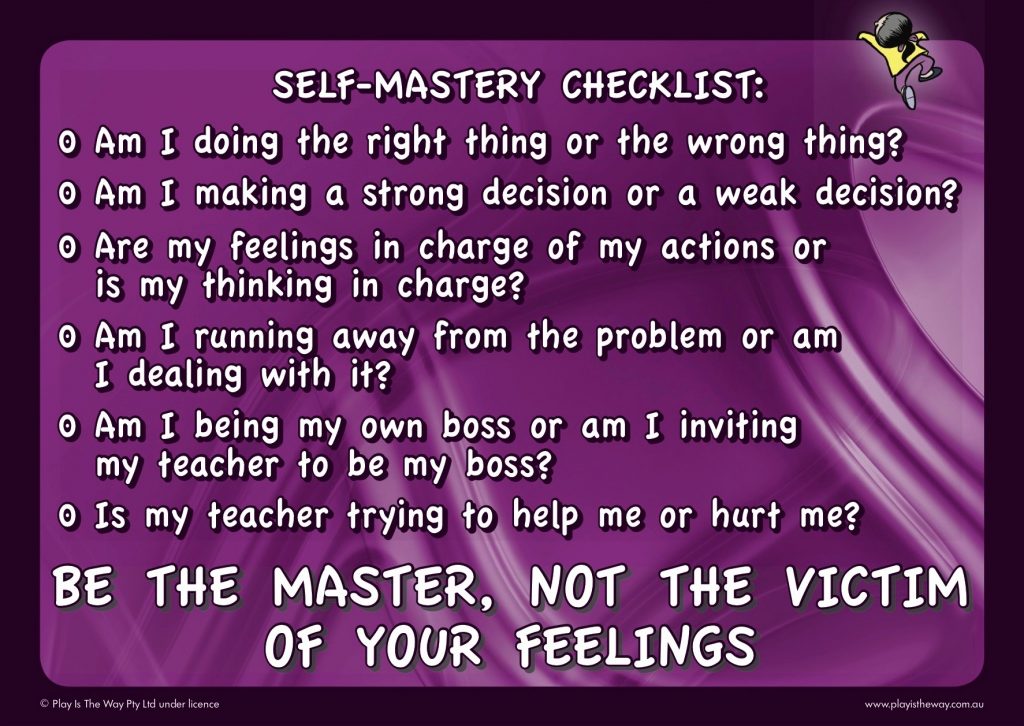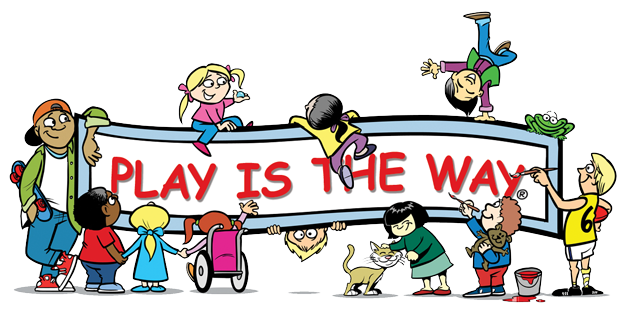By Wilson McCaskill
It is important that the 5 Play Is The Way® (PITW) key concept posters and the self-mastery checklist don’t disappear into the background clutter of classroom walls. Too often, they are pinned up in a neat row or block that only attracts the eye of a classroom visitor who is seeing everything in the room for the first time. To students, the posters have become, as has much else on the walls, invisible.
Understandably the want of many teachers is to fill their classrooms with the work of students and the many other teaching prompts and aids that are at their disposal. This visual stimulation can become an explosion of shape and colour as the term progresses and while it may point to the productivity of the class it certainly requires a sharp eye and excellent awareness to locate any one item that may be of assistance.
There are many good educational reasons to fill blank walls and the empty space above heads with copious amounts of stimulation, but my concern is to try and ensure that the core subject of behaviour education and the props and tools that support it are, in fact, stimulating, informative and effectively guiding students on a daily basis.
As behaviour is too often the unlisted subject of education and given little prominence in so many classrooms, it must be afforded every opportunity, by teachers who understand its importance, to remain front and centre in the minds of students.
To this end, I would like to propose ways of using and displaying the PITW key concept posters that create more active student engagement and thereby improve their impact and benefit.
NOTE: As the maturity and skills of a class cannot necessarily be determined by its age or grade, I shall leave it to the teacher to decide which of these suggestions is most suitable for his or her class and the degree to which a suggestion needs to be adapted and adjusted before it can be applied.
ONE AT A TIME
The important thing is not to pin all the posters up at once. Pin them up as you work through them using the Life Raft activities.
When you pin up the first poster (usually the orange one) don’t leave it in the same spot day in and day out. Start the day by getting students to locate the poster in the room. You can even go as far as to make finding it a “Where’s Wally?” moment in the day. Don’t be reluctant to sneakily shift the poster around during the day while encouraging student to always be aware of where it is.
An enjoyable way to maintain a consciousness of the poster and to lift the energy of the group is to, at various moments in the day, callout, “Orange!” and see how quickly students can locate the poster and point to it. This can be done regardless of the number of posters pinned up, as each is a different colour. Obviously, it is fun to call “Orange!” when they least expect it or to just slip the word into a sentence at anytime to see if students pick up the word and point to the poster.
As your objective is to try and get students to memorise the key phrase on each poster, it helps, after the poster has been located, to get a student to call out the key phrase without looking at the poster.
Eventually you will have worked through each poster and all of them will be on display. Placing them in a line or block makes it too difficult to single out the requested poster and point at it. With each poster in a different spot in the room students will need to be alert and aware to locate and point at them quickly. You can of course call out more than one colour at a time and give students the challenge of pointing to the posters in the colour sequence you called.
MORE STRATEGIES
- The more posters you have up, the more strategies and variations you can employ to keep students actively engaging with the posters and embedding the concept contained within each.
- Ask a student to look around at all the posters and determine which one is having the greatest influence on his or her behaviour at the present time (self-awareness). Having decided, he or she (without looking at it) is to call out the colour or the key phrase and the class must locate that poster as quickly as possible. This can of course be done with multiple students. Once done, you may want the students to give reasons for their decision.
- When students are working in groups, nominate a student from each group to point to the poster they believe, after due consideration, their group needs to be more strongly influenced by. As soon as they do so, the class must call out in unison, the key phrase of that poster. Again, you may want the students to give reasons for their answers. You may also want to invite students within each group, to share any contrary opinions.
- At the end of the day, with the posters spread around the room, invite children to go and stand near the poster they consider, after a day of learning, to be their greatest strength. Let them think, pair and share their reasons for thinking so.
- Now ask them to stand near the poster that they needed to be more conscious of and repeat the think, pair, share process. This is a good way to introduce some movement into the class to freshen brains and energise bodies.
- Invite a student to take the poster off the wall that they think will be of the most assistance to them in the learning that is about to commence and place it on his or her desk. Ask him or her to read the poster out to the class and ask for a show of hands from those who think that they, likewise, would be helped by the message of the poster. This can be done for each of the remaining posters.
- At the completion of the learning ask those with the posters to assess their behaviour in reference to the poster. Determine if others in the class would agree with that assessment (social awareness). It maybe that the student is unduly harsh upon themselves and needs to hear from other students that he or she has indeed been employing the guidance of the chosen poster.
- Invite a student to give a poster to a member of the class who they think has been a good role model of that guiding concept during the past activity or day, week, etc. Ask them to share the evidence for their decision. You could also ask for any support or opposition to that decision. Opposition invariably leads to discussion, which if guided well can be rewarding and fruitful.
- Take all the posters off the wall and holding them upside down, fan them out like a hand of playing cards and ask some students to pick a poster. Having done so, their challenge is to act as the model of that concept. After a period of time the class is asked to share examples of the student’s modelling and any moment that modelling positively affected them or the learning they were doing. Repeat the process and invite another group of students to pick a poster.
- Remove a poster from the wall and replace it with a blank sheet of paper. Ask students to inform you of which poster is missing. Their objective now is to identify students who are acting as models of that concept and when convenient place a tick (using a marker that is the same colour as the poster) on the sheet for each student they see actioning the concept. This should be done without fanfare and students are not required to inform those they have witnessed. At the end of the day, ask students to contemplate the sheet, and the quantity of ticks, and consider if that concept is a class strength or if it needs more application. You could also ask them to describe, in general terms and without using names, the behaviours they witnessed that show the concept in action.
Example:
I saw a person hang-in-there and try his best even when everyone else had already finished.
- Keep the posters with you as you conduct the class and be ready to give snap assessments of individuals or groups by flashing the posters you think best describes the behaviour of those individuals or groups. Call the students out by name and make sure they see your assessment. Conversely, you could flash the poster you believe would be to their advantage if they employed it.
- Another way is to hold up two posters and ask individuals or groups to select which of the two they need to focus on to improve their behaviour and learning outcomes.
- Yet another is to describe their behaviour by the colours of the posters.
Example:
Mary, you are having a really strong blue moment. Keep it up, please.
Tom, I think you need to think about the green poster and have a green moment and Richard a red moment will help you to help Tom. Thanks, boys.

THE SELF-MASTERY CHECKLIST (purple poster) is at its most influential when students are asking themselves and each other the questions. For this to happen teachers must encourage students to look at the poster and select the question that would be of most benefit in guiding their behaviour. Once selected, the student should vocalise the question quietly to himself once and then repeat it in his own head. If reading is the problem, then teachers need to read each question out loud and ask the student to repeat the question followed by his or her answer.
A useful strategy is to offer students two questions from the checklist and ask them to select the one that is the most applicable and apply it to direct their behaviour. This strategy can speed up the process of selection, as some students feel a little overwhelmed by having six questions to consider. The teacher of course includes, in the pair of questions, the question they believe would be of most help to the student.
An effective and engaging way to help students learn the questions is to invite them to form pairs where each student in the pair acts as the conscience of the other. (ReadTHE LOSS OF CONSCIENCE article on our website). Their task is to offer assistance, when and if it is needed, by way of asking one or more of the self-mastery questions. Before acting as the conscience of their partner they start with the line, “This is your conscience speaking.” Their partner’s first response is, “I’m listening conscience.” The interaction should end with, “I hope you make the right decision.”
Example:
(Tom is the conscience of Richard and vice versa. When speaking to Richard he does it in a quiet and confidential manner.)
TOM: This is your conscience speaking.
RIC: I’m listening conscience.
TOM: Are you running away from the problem or are you dealing with it?
RIC: I don’t care.
TOM: Are you having a strong moment or weak moment?
RIC: Shut up.
TOM: I hope you make the right decision.
You may need to have some pairs demonstrate the process to ensure the start and end lines are remembered. There will, quite naturally, be some humour and self-consciousness arising from the use of this strategy but that will settle and result in some timely and helpful guidance being shared between some pairs. It will also help students to memorise and become comfortable with the questions. Don’t let the discomfort and possible embarrassment of students when trying this strategy sway you from sticking with it. Often, it is our adult belief in the value of an idea or strategy that gets children over the hurdle of their own apprehension, awkwardness or fear.
Hopefully, these suggestions trigger even more ways you can devise to use the posters in an active and engaging way. The main point is that the last thing you want is to have the posters, and the powerful guidance they offer, reduced to insignificance on a forgotten spot on the wall. Behaviour education is simply too important and vital for that to happen.

